Hands On with USB Type C: Reversible USB Connectors
by Joshua Ho on September 11, 2014 9:00 AM EST- Posted in
- Smartphones
- Mobile
- Laptops
- Tablets
- USB-IF
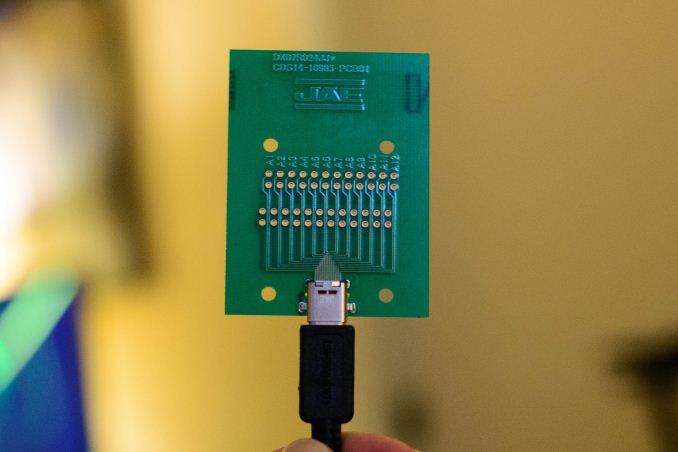
Today, the USB-IF brought me in to see the long-awaited USB Type C cables. We've written about this before, but for those that aren't familiar with this new USB spec, the USB Type C cable and USB 3.1 spec are designed with the future in mind. As a result, there are a lot of new features to talk about. We'll start with the USB 3.1 spec before we get into the Type C connector.
With USB 3.1, we see a few key improvements. Peak throughput goes to 10 Gbps from 5 Gbps, which translates to a peak of 1.25 GB/sec. In a demo of an early controller with two SSDs attached to the system I saw peak throughput of 833 MB/sec. As a side note, I also saw a demo of wireless USB connectivity from smartphone to laptop and laptop to smartphone, which was definitely pretty cool. Getting back to the USB 3.1 spec, USB Power Delivery 2.0 (PD) makes it possible for USB to supply up to 100 watts, and coexists with the BC 1.2 spec that is used in USB power adapters to charge phones so a single port would be able to provide power for both systems. In addition, USB PD 2.0 allows for power to go both ways without changing the direction of the cable, so a laptop would be able to send and receive power from the same port. Finally, USB Type-C extensions mean that it's possible to do all kinds of interesting applications over USB ports, such as sending audio and video data. It's even possible for a USB Type C port to send PCI-E data through the connection for use cases such as a two in one convertible tablet.
This opens up the possibility for a dock scenario where a single cable to the monitor can charge a laptop and also mirror the laptop's display onto the external monitor, and the external monitor would also be able to serve as a USB hub for a keyboard, mouse, headsets, flash drives, and other USB peripherals. While the laptop charging aspect and integrated USB hub in display wasn't demonstrated in the prototype I saw, everything else was fully working as shown in the photo above.
I was also able to get some photos of the cable and receptacle. Unfortunately it took flash to really show the detail in the connector but it definitely will be a great standard for all kinds of applications. While I'm sure that there will be differences in the final product, the reversible plug works just like expected and could be quickly inserted from behind the back. The USB-IF believes that this standard will show up in products shipping in 2015. It does seem that the connector is a bit less compact than microUSB, but the benefits outweigh this increase in size.


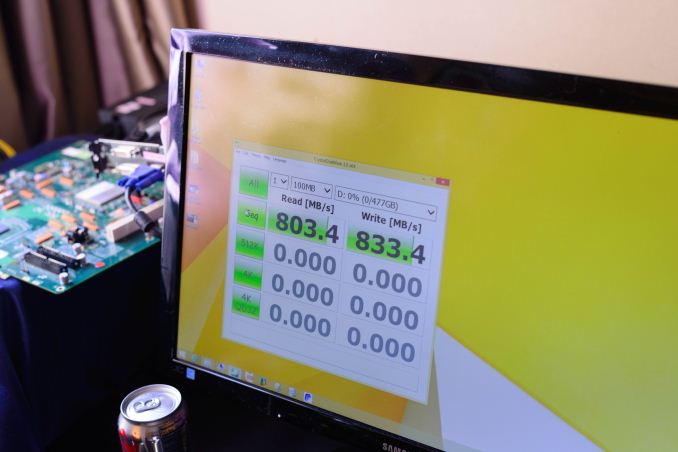
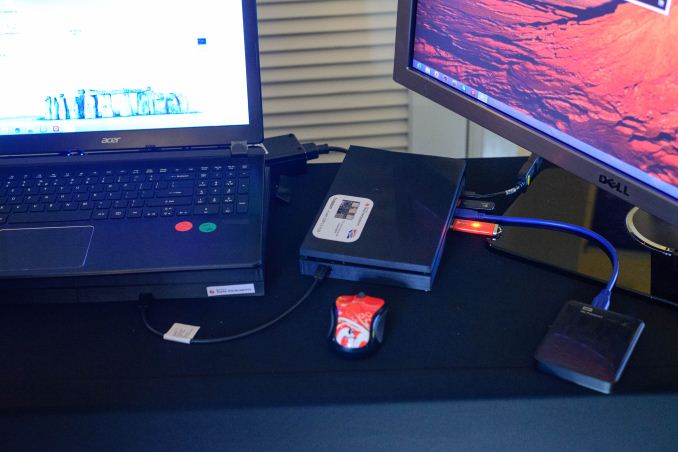
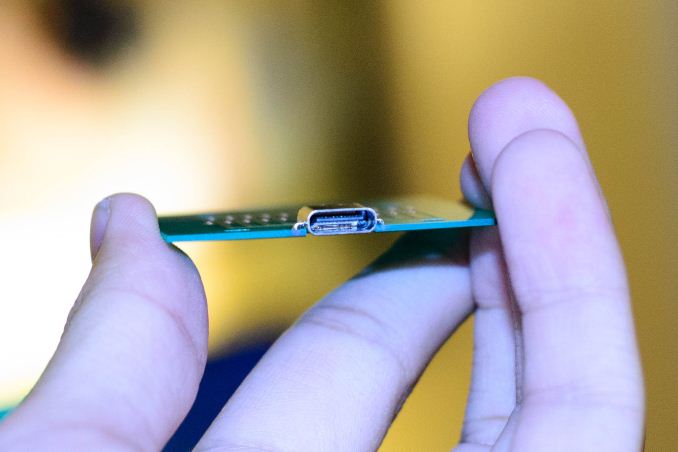
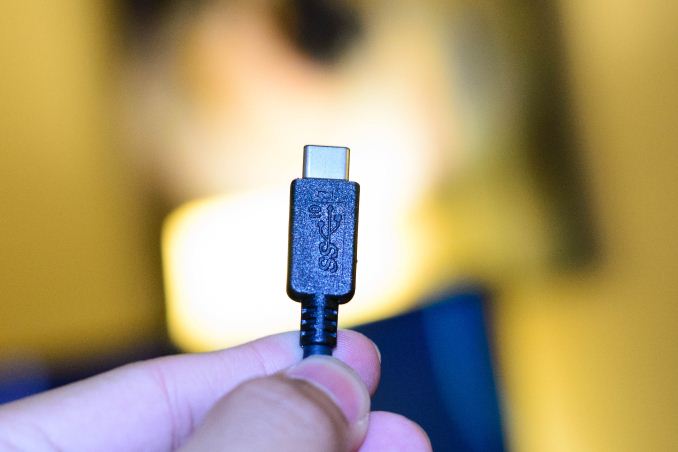
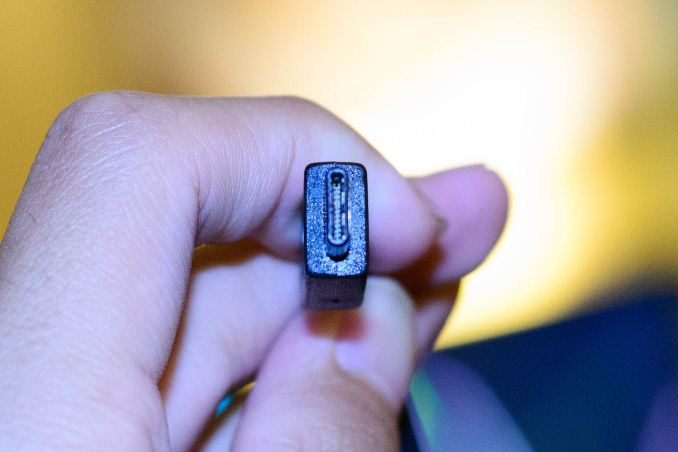








91 Comments
View All Comments
Impulses - Thursday, September 11, 2014 - link
Ha! When pigs fly... They'll just release some adapter like when they "agreed" to support 2.0.Penti - Thursday, September 11, 2014 - link
Actually the same suppliers and designers (they own the tech not Apple) is involved with both Lightning and USB 3.1 Type-C. Standardization do take some extra time.Wolfpup - Thursday, September 11, 2014 - link
I don't think it is important. Regardless, the Lightning connection/port is defective. Clearly not ALL of them go, but a large enough number that there are threads all over the place with people with dead Lightning connector devices (and cables).I've given up on Apple until they switch to USB, after having my FOURTH Lightning device fail on me (not counting cables). iPhone 5s which lasted me 10 months (and probably only 10 months because I babied it so much.
kezeka - Thursday, September 11, 2014 - link
I genuinely have had ZERO problems with lightning connectors or any of the lightning devices that I own. I know many people with the exact same experience. Two friends have had problems with their power buttons failing but apple swooped in with a recall on those.I can help but think you are overdramatizing here or that you have an incredibly rough personal usage model. Either way, if you are running into that many failures I find it hard to believe that it is the device and not the user. I predict poor success with any mobile device - android or apple or Microsoft based - in your future.
samsonjs - Thursday, September 11, 2014 - link
It's common for the port to get blocked up with lint. If your phone doesn't charge clean out the port and give it another shot.fteoath64 - Saturday, September 13, 2014 - link
What are ought to be appalled with is why Apple did not make a magsafe type connector instead of a plug!!!. (Obvious isn't it) Anything that had protruding parts and a non-flexible head-connect will be subjected to breakage. Apple knows the number of cable complains and their poor quality Lightning cables. Had they made a smaller magsafe connector (reversible) then those breakages will just go-away and cables lasts a lot longer like the older 30-pin connectors working well 6 years later!!!.The standard Lightning cable hardly last a year!. Magsafe was a great concept being able to break away on accidental trips on the cables or device!.
Conficio - Saturday, September 13, 2014 - link
Two reasons:* MagSafe connectors are too big to fit mobile devices (they need a ring of magnets)
* MagSafe connectors are not fail safe either, I had one broken by my 3 yr old and you can read happily on the net how many people try to replace their mag safe cables on their chargers.
flatrock - Monday, September 15, 2014 - link
Apple has managed to come up with a lot of things that probably should have been obvious, but were overlooked by the rest of the industry. It has usually been related to putting better user interfaces on products that had a lot of room for improvement in that area. A reversible connector is kind of along the same lines. It does the same thing as what was on other devices, but made using it a bit easier.xilience - Thursday, September 11, 2014 - link
Could you post a comparison of the USB type C vs Lightning specs and featureset?ascend - Thursday, September 11, 2014 - link
A minor but important typo: "Peak throughput goes from 10 Gbps from 5 Gbps"Now I'm not sure which side meant to say "to".